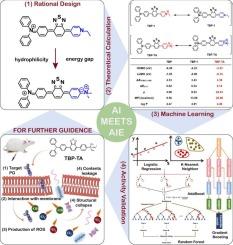当AI遇到AIE时:机器学习设计面向功能的抗菌能力aigens
IF 13.2
1区 工程技术
Q1 ENGINEERING, CHEMICAL
引用次数: 0
摘要
虽然三苯胺(TPA)型聚集诱导发射发光原(AIEgens)对革兰氏阳性多药耐药菌的光动力治疗能力已得到证实,但由于实验程序复杂,抗菌机制尚不清楚,限制了新型功能型TPA型AIEgens的合理设计。在此,我们提出了一种结合理论计算和机器学习的基于知识的人工智能(AI)方法,以辅助合理设计和预测新型tpa型抗菌药物的抗菌能力。我们首先构建了一种新的tpa型AIEgens,简称TBP-TA,追求与活性氧生成和细菌结合能力直接相关的更低的能隙和更高的亲水性,最终增强抗菌能力。在理论计算确认了预期的物理化学特征后,基于一个包含38个已报道的tpa型AIEgens的自制数据库和本工作建立的机器学习模型,预测了ttp - ta的抗菌能力。在基于知识的人工智能预测结果中,TBP-TA对革兰氏阳性多药耐药菌表现出抗菌能力。此外,体外和体内抗菌实验结果表明,TBP-TA对耐甲氧西林金黄色葡萄球菌的杀灭能力与万古霉素相当。最后,对TBP-TA的抗菌机制进行了深入探讨。我们提出的基于知识的AI方法代表了开发强效AIE抗菌剂的范例,其成本显著降低,成功率显著提高。本文章由计算机程序翻译,如有差异,请以英文原文为准。

When AI meets AIE: Machine learning in design function-oriented AIEgens for antibacterial ability
Although photodynamic therapy ability of triphenylamine (TPA)-type aggregation-induced emission luminogens (AIEgens) for Gram-positive multidrug-resistant bacteria have been proofed, rational design of new function-oriented TPA-type AIEgens with high antibacterial ability is still limited by complicated experimental procedure and unknown antibacterial mechanism. Herein, we proposed one novel knowledge-based artificial intelligence (AI) approach combining theoretical calculation and machine learning to assist rationally design and predict antibacterial ability new TPA-type AIEgens. We firstly constructed one new TPA-type AIEgens abbreviated TBP-TA, pursuing lower energy gap and higher hydrophilicity that directly related to reactive oxygen species generation and bacteria binding ability, finally enhancing antibacterial ability. After confirmation of expected physicochemical features by theoretical calculation, the antibacterial ability of TBP-TA was predicted based on one homemade database containing 38 reported TPA-type AIEgens and machine learning models built in this work. As expected, TBP-TA exhibited antibacterial ability toward Gram-positive multidrug-resistant bacteria in prediction result provided by knowledge-based AI approach. Furthermore, in vitro and in vivo antibacterial results proved the excellent eliminating ability of TBP-TA to methicillin-resistant S. aureus comparable to vancomycin. Lastly, the antibacterial mechanism of TBP-TA was explored exhaustively. The knowledge-based AI approach we proposed represented a paradigm for the development of powerful AIE antibacterial agents with significantly reduced cost and increased success rate.
求助全文
通过发布文献求助,成功后即可免费获取论文全文。
去求助
来源期刊

Chemical Engineering Journal
工程技术-工程:化工
CiteScore
21.70
自引率
9.30%
发文量
6781
审稿时长
2.4 months
期刊介绍:
The Chemical Engineering Journal is an international research journal that invites contributions of original and novel fundamental research. It aims to provide an international platform for presenting original fundamental research, interpretative reviews, and discussions on new developments in chemical engineering. The journal welcomes papers that describe novel theory and its practical application, as well as those that demonstrate the transfer of techniques from other disciplines. It also welcomes reports on carefully conducted experimental work that is soundly interpreted. The main focus of the journal is on original and rigorous research results that have broad significance. The Catalysis section within the Chemical Engineering Journal focuses specifically on Experimental and Theoretical studies in the fields of heterogeneous catalysis, molecular catalysis, and biocatalysis. These studies have industrial impact on various sectors such as chemicals, energy, materials, foods, healthcare, and environmental protection.
 求助内容:
求助内容: 应助结果提醒方式:
应助结果提醒方式:


